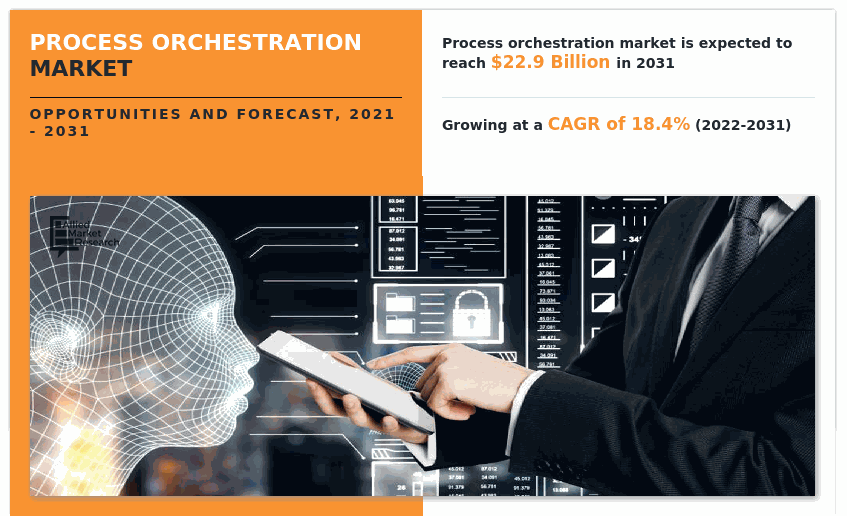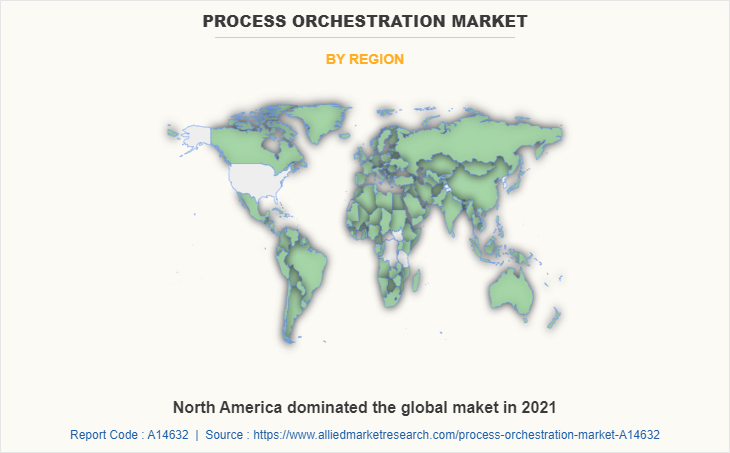Process Orchestration Market Research, 2031
The global process orchestration market was valued at $4.4 billion in 2021, and is projected to reach $22.9 billion by 2031, growing at a CAGR of 18.4% from 2022 to 2031.
The increase in adoption of business process automation technologies by businesses to improve efficiency, quality of business operations, and interactions with other companies & customers, as they involve in e-business transactions are some factors that drive the process orchestration market growth. In addition, the rise in deployment of sufficient business solutions by organizations to reduce operational costs and efficiently utilize their IT resources drives the market growth.

However, lack of knowledge among users, misunderstanding around business process orchestration, and rise in regulations & compliance requirements are expected to hamper the growth of the market. Furthermore, the integration of latest technology such as artificial intelligence and improved IT methods to meet customer’s dynamic requirements are expected to provide lucrative opportunities to the process orchestration market.
Process orchestration is the platform, which allows the orchestration of several business activities among individuals, processes, & systems and is used for developing custom workflow operations. It provides a platform, which supports both IT & business experts to work together & monitor business process applications and safely exchange the information. This platform helps businesses to effectively serve the business processes.
In addition, it is well-known to push forward the efficiency of business operations. The selection of such platforms has reduced manufacturing costs, helped to enhance the value chain and the whole operations of an organization. Business process orchestration is the method of controlling the business process with the help of web-based services. This process assists in developing future of business process management and has the capability to change the way of business and information technology interaction. Business process orchestration is described as business process, workflow, or instrumentation of services. It outlines the company's internal control flow framework and provides detailed information about the limitations and occurrence process.
Segment Review
The Process Orchestration market is segmented on the basis of component, organization size, deployment, industry vertical, and region. On the basis of component, the market is segmented into software and services. According to the organization size, it is fragmented into large enterprises and SME’s. On the basis of deployment, the market is segmented into cloud and on-premise.
Depending on industry vertical, process orchestration market share is segregated into BFSI, manufacturing, healthcare & pharmaceuticals, IT & telecommunications, retail and consumer goods, government & defense, energy & utilities, transportation & logistics and others. Region wise, it is analyzed across North America, Europe, Asia-Pacific, and LAMEA.
Services is projected to be the most lucrative segment
By Component
In 2021, On the basis of component, the software segment dominated process orchestration market size, and is expected to maintain its dominance in the upcoming years. The process orchestration software helps to standardize, consolidate and automate best practices for business processes in complex environments.
BFSI was the most significant segment in 2021
By Industry Vertical
However, the service segment registered highest growth rate during process orchestration market forecast period. The services related to the process orchestration provides services for orchestration technology for various strategies and these strategies will ensure smooth running and troubleshooting of the any glitches within the solutions. These services associated cloud orchestration technologies help in gaining knowledge of technologies, which are driving the expansion of the market.
By Industry Vertical, BFSI segment dominated the growth in the process orchestration industry in 2021, and is expected to maintain its dominance in the forecasted period. Banking institutions around the world are rapidly adopting a variety of digital technologies and channels to increase their footprint and revenue.
In addition, customer preference is shifting towards digital platforms. However, healthcare & pharmaceuticals segment registered highest growth rate during forecasted period. The healthcare sector is currently facing a dramatic change brought about by the digitalization of services, more effective and cost-efficient care models, and self-care promoting personalized healthcare. Increased costs and the promise of connected health technologies have created a need for adoption of process orchestration for cost effectiveness and improved efficiency of healthcare systems.

North America dominates the process orchestration industry in 2021. Growth of the market in this region is attributed to several factors such as increase in digitalization and adoption of process orchestration tools by end users such as BFSI and retail. Moreover, presence of key players is providing ample growth opportunities for market growth. However, Asia-Pacific is expected to observe highest growth rate during the forecast period. This is due to the increase in economic transformation, globalization, digitization, and the rise of cloud-based process orchestration solutions. In addition, the increasing awareness among enterprises regarding the benefits of process orchestration, such as enhanced business planning and elimination of process redundancy, also acts as a major factor toward the demand for process orchestration software.
Top Impacting Factors
Growth in demand for digital transformation
Customer expectations are constantly evolving with emerging technologies, and so businesses are investing in digital transformation in an attempt to continue to meet customer expectations. Digital transformation is all about implementing and adopting automation technologies for better business operations and decision making. Process orchestration solutions are one of the most sought digital technologies by enterprises for better efficiency and utilize their IT systems for catering to their customers’ dynamic requirements. For instance, as per International Data Corporation (IDC), 75% of organizations are expected to have digital transformation implementation roadmaps by 2023, up from 27% registered in 2020.
Surge in demand for optimum resource utilization
Organizations across the world focus on the best usage of available resources such as storage, computing power, and engineering resources. Process orchestration provides professional and managed services along with cloud orchestration services enabling organizations to focus on various processes such as other parallel projects. Thus, process orchestration ensures optimum resource utilization. In addition, the simplified optimization helps organization to be more productive along with pay per usage flexibility, which in turn is anticipated to enhance the market growth.
In addition, by having the information about the availability of resources and conclude them at the right time for the project, plays a vital role in managing the costs and smooth execution on the project activities. It leads to significant benefits to any kind of business or organization. These benefits of process orchestration is driving the market growth.
COVID-19 Impact Analysis
The global process orchestration Market was valued at $4,398.0 million in 2021, and is projected to reach $22,859.8 million by 2031, registering a CAGR of 18.4% from 2022 to 2031. The current estimation of 2030 is projected to be higher than pre-COVID-19 estimates. The pandemic has prompted every company and business to shift their business operations toward a remote work environment. As a result of the dire situation, companies began to implement process orchestration tools for better efficiency and improved business agility.
Moreover, during the COVID, due to work from home policies, the demand for cloud-based solutions and the SaaS-based model increased significantly. This has positively impacted the market growth. Incidentally, during the pandemic, process orchestration and automation helped eliminate the dependency on staff availability, thus supporting both remote working and ensuring business resilience.
Key Benefits For Stakeholders
- This report provides a quantitative analysis of the market segments, current trends, estimations, and dynamics of the process orchestration market analysis from 2021 to 2031 to identify the prevailing process orchestration market opportunities.
- The market research is offered along with information related to key drivers, restraints, and opportunities.
- Porter's five forces analysis highlights the potency of buyers and suppliers to enable stakeholders make profit-oriented business decisions and strengthen their supplier-buyer network.
- In-depth analysis of the process orchestration market segmentation assists to determine the prevailing market opportunities.
- Major countries in each region are mapped according to their revenue contribution to the global market.
- Market player positioning facilitates benchmarking and provides a clear understanding of the present position of the market players.
- The report includes the analysis of the regional as well as global process orchestration market trends, key players, market segments, application areas, and market growth strategies.
Process Orchestration Market Report Highlights
| Aspects | Details |
| By Industry Vertical |
|
| By Component |
|
| By Deployment Model |
|
| By Enterprise Size |
|
| By Region |
|
| Key Market Players | SAP SE, International Business Machines Corporation, Computer Associates International Inc, Fujitsu Limited, TIBCO Software Inc., Cisco Systems Inc, Oracle Corporatio, HCL Technologies Ltd., Software AG, Wipro Limited. |
Analyst Review
The global process orchestration market is projected to witness prominent growth, especially in Asia-Pacific and North America. This growth is attributed to increased investments by organizations and governments for automation and adoption of cloud-based process orchestration solutions. In addition, the adoption of IoT (Internet of Things) based devices globally provides ample growth opportunities for process orchestration solutions.
The current business scenario has witnessed an upsurge in the adoption of process orchestration solutions in developed as well as developing regions as process orchestration solutions maximizes business efficiency by minimizing operational efforts with faster processing times and lower labor costs, enhancing its adoption in the process orchestration market.
Moreover, enterprises make significant investments in R&D to enhance their existing solutions and deliver new solutions as well as develop new machine intelligence and automation technologies. For instance, in February 2019, IBM invested USD 2 billion in its new research hub for artificial intelligence (AI) in New York. This investment will enhance the company’s efforts to enhance growth from emerging technologies by transforming business operations benefitting the process orchestration market.
Asia-Pacific exhibits the highest adoption of process orchestration solutions. On the other hand, LAMEA is expected to grow at a significant growth rate, predicting a lucrative market growth for process orchestration solutions, especially in countries such as Brazil, South Africa, and Argentina.
The global Process Orchestration Market was valued at $4,398.0 million in 2021, and is projected to reach $22,859.8 million by 2031, registering a CAGR of 18.4% from 2022 to 2031.
North America dominated the global market
The integration of latest technology such as artificial intelligence and improved IT methods to meet customer’s dynamic requirements are expected to provide lucrative opportunities to the process orchestration market.
BFSI, manufacturing, and healthcare and pharmaceuticals
Some of the major players in the market are BMC Software, Inc., CA Technologies, Cisco Systems, Inc., HCL Technologies Limited, Micro Focus, Oracle Corporation, SAP SE, ServiceNow, Inc., and TIBCO Software, Inc.
Loading Table Of Content...


